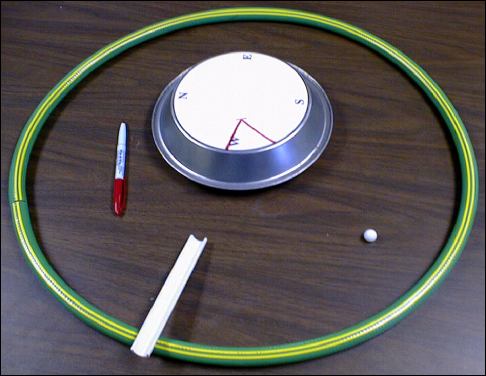
Background:
No instrument allows the atom's nucleus to be observed directly, so scientists have to find other ways to learn about it. Scientists at Jefferson Lab use a machine called an electron accelerator to probe atomic nuclei. This accelerator takes electrons, forms them into a beam about the width of a human hair and speeds them up to nearly the speed of light. This fast moving beam of electrons is then directed at a target. Some of the electrons in the beam interact with some of the atoms in the target. When this occurs, the electron changes direction and some particles could fly out of the nucleus. Detectors placed around the target record the paths of the electron and nuclear fragments. These collisions provide scientists with clues about the structure of the nucleus.
By bouncing a marble off of a hidden target, students simulate the experiments done at Jefferson Lab.
Objectives:
In this activity students will:
- work in groups
- roll a marble under a pie pan and observe where it comes out
- record the path the marble took under the pie pan on a sheet attached to the top of the pie pan
- find the wall the marble bounced off of by constructing a perpendicular line to the path's bisector
- collect additional data by repeatedly rolling the marble under the pie pan
- form a hypothesis as to what shape is hidden under the pie pan based on the data they collected
- prove their hypothesis by predicting the outcome of additional marble rolling experiments
Minimum Materials Needed for Each Student Group:
- Several wooden shapes hidden underneath pie pans
- A marble
- A ramp
- A pen or marker
- Data sheets
- A containment fence

Materials for The Shape of Things
Pre-Activity Preparations:
The Pie Pans
1. Attach a wooden shape to the inside of a pie pan. When the pie pan is inverted, the wooden shape should be completely hidden from view.
2. Check to make certain that there is enough room for the marble to roll underneath the pie pan. Add some spacer material between the wooden shape and pie pan if necessary.
3. Attach a data sheet to the top of each pie pan.
The Ramp
1. Cut a 15 centimeter piece (~6 inch) of PVC pipe in half lengthwise.
2. Use sandpaper to flatten one end of the ramp to help stabilize it.
The Containment Fence
1. Cut a one meter length (~3 feet) of garden hose and attach the ends together with a short length of dowel.
Notes:
- Basic geometric shapes are best for beginners. More elaborate shapes can be constructed for advanced groups.
Citation and linking information
For questions about this page, please contact Carol McKisson.
